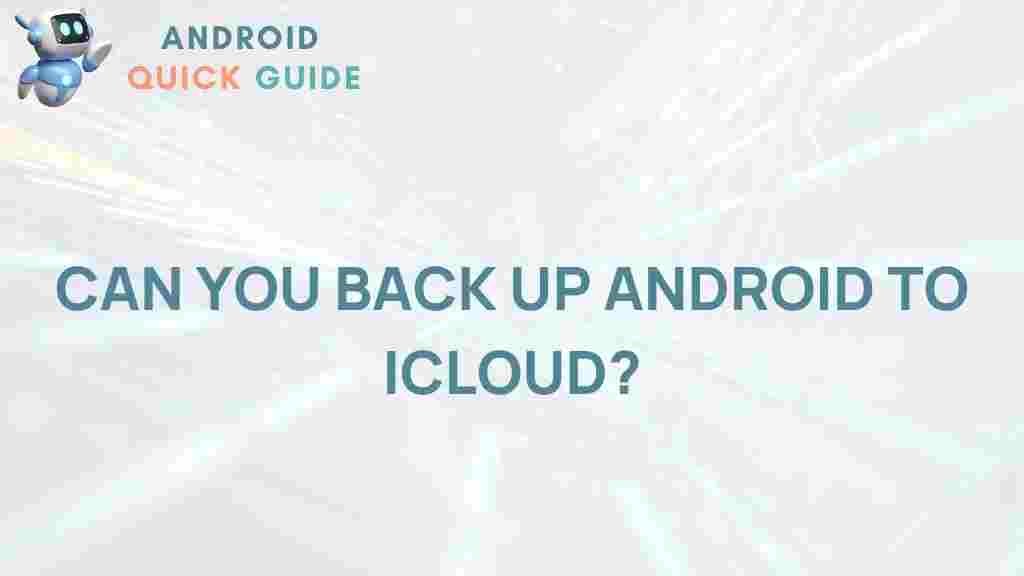In a world where technology is advancing rapidly, the need for cross-platform compatibility between Android and iOS devices has become more significant. One question that frequently arises is whether Android users can back up their devices to iCloud, Apple’s popular cloud storage service. This article explores this topic in detail, providing insights, practical steps, and troubleshooting tips for those looking to bridge the gap between Android and iCloud.
Can Android Devices Back Up to iCloud?
Many Android users wonder if it’s possible to back up their devices to iCloud, especially if they’ve previously used an iOS device or have other Apple products. While Android and iCloud are designed for different ecosystems, there are ways to access some iCloud functionalities on an Android device. Although a full backup may not be feasible, certain workarounds allow you to sync essential data between platforms.
Understanding the Basics of Android and iCloud Compatibility
To begin, it’s essential to understand that Android and iOS operate on two entirely different systems. Android, developed by Google, has its own cloud backup solutions, such as Google Drive, whereas iCloud is an Apple-exclusive service primarily designed for iOS devices like iPhones, iPads, and Mac computers. Despite these differences, users can take advantage of certain iCloud services on Android devices through specific steps.
Step-by-Step Guide to Access iCloud on Android
If you’re looking to access some iCloud functionalities on an Android device, here’s a step-by-step guide:
Step 1: Access iCloud Using a Web Browser
Since there’s no official iCloud app for Android, the easiest way to access iCloud from an Android device is through a web browser. Follow these steps:
- Open the web browser on your Android device.
- Go to iCloud.com.
- Log in with your Apple ID and password.
- From here, you can access services like iCloud Photos, iCloud Drive, Notes, and Find iPhone.
This method allows limited access to iCloud, primarily for viewing and downloading files rather than a full backup. If you’re primarily looking to access iCloud Photos or Notes, this solution may be enough for your needs.
Step 2: Transfer Photos and Files from Android to iCloud
If you’re looking to move files or photos specifically, another option is to transfer them manually from Android to iCloud. Here’s how:
- On your Android device, open the Google Photos app (if your photos are stored here).
- Select the photos or files you want to transfer.
- Download these files to your computer or use a cloud storage service like Google Drive.
- Open iCloud.com on a computer, log in, and upload the files to iCloud Photos or iCloud Drive.
While this approach may seem a bit tedious, it’s effective if you need to move specific files to iCloud. Additionally, this can be a useful way to back up important photos from your Android device to iCloud as a secondary storage option.
Step 3: Sync Calendar, Contacts, and Email
For users who need to sync contacts, calendars, or emails between Android and iCloud, this can be done using third-party apps or by setting up email forwarding:
- To sync your iCloud email, add your iCloud account to your Android’s email app using IMAP settings.
- Syncing contacts and calendars requires apps like SmoothSync for Cloud Calendar or CardDAV-Sync for contacts, which are available on the Google Play Store.
- Once configured, these apps allow you to sync contacts and calendar events across both devices seamlessly.
Note that syncing contacts and calendars via third-party apps may require additional setup but can be helpful for maintaining a consistent user experience across Android and iOS devices.
Troubleshooting Tips for Accessing iCloud on Android
If you encounter issues while accessing iCloud on Android, here are some troubleshooting tips:
1. Ensure a Stable Internet Connection
Accessing iCloud on Android requires an internet connection. Ensure that you have a stable Wi-Fi or mobile data connection to prevent loading issues on the iCloud website.
2. Clear Browser Cache and Cookies
If you’re accessing iCloud via a browser and experience difficulties, try clearing the cache and cookies. This often resolves issues related to login errors or pages failing to load correctly.
3. Enable Two-Factor Authentication
If you use two-factor authentication with your Apple ID, ensure that you have a trusted device nearby for the verification code. Alternatively, you can generate a code from another Apple device or update your account settings to allow access from an Android browser.
4. Use an Updated Browser
For the best experience, use a modern, updated browser like Google Chrome or Firefox on your Android device. Outdated browsers may not support all of iCloud’s features, leading to potential issues.
Alternative Backup Solutions for Android Users
Given that a full backup to iCloud from Android is not possible, here are some alternative solutions for Android backups:
- Google Drive: Google offers robust backup options for Android devices, including Google Photos for images, Google Contacts for contact information, and Google Drive for documents. These backups are stored in your Google account and can be restored easily.
- Third-Party Cloud Services: Apps like Dropbox and Microsoft OneDrive offer alternative backup solutions that are accessible on both Android and iOS, providing a convenient way to access files across devices.
For those who need a full Android backup, it’s recommended to use Google’s built-in options, as they offer seamless integration and data restoration.
Conclusion
While a direct iCloud backup for Android is not currently supported, Android users have multiple ways to access some iCloud services. By using a web browser, third-party apps, and alternative backup solutions, you can sync and back up essential data across Android and iOS platforms. These methods make it easier to enjoy the benefits of both ecosystems without significant compromise.
For more detailed instructions on managing data between Android and iOS, check out our guide on cross-platform data management.
This article is in the category Guides & Tutorials and created by AndroidQuickGuide Team
